생후 4∼6개월 영아들의 성장과 발육, Growth and development of 4~6-month-old infants
표 3-4. 생후 4개월 된 한국 영아들의 체중과 신장의 백분위수
|
백분위수
성별 |
3 | 10 | 25 | 50 | 75 | 90 | 97 | |
| 남아 | 체중(kg) | 5.70 | 6.20 | 6.80 | 7.30 | 8.00 | 8.70 | 9.40 |
| 신장(cm) | 59.0 | 61.0 | 63.0 | 64.6 | 66.2 | 68.2 | 70.1 | |
| 여아 | 체중(kg) | 5.10 | 5.90 | 6.40 | 6/86 | 7/30 | 8.20 | 9.10 |
| 신장(cm) | 58.0 | 60.0 | 61.6 | 63.2 | 65.0 | 67.4 | 69.3 |
표 3-5. 5개월 한국 영아들의 체중과 신장의 백분위수
|
백분위 수
성별 |
3 | 10 | 25 | 50 | 75 | 90 | 97 | |
| 남아 | 체중(kg) | 6.0 | 6.50 | 7.09 | 7.73 | 8.35 | 9.00 | 9.60 |
| 신장(cm) | 59.9 | 62.0 | 64.0 | 66.0 | 68.0 | 69.7 | 72.0 | |
| 여아 | 체중(kg) | 5.45 | 6.00 | 6.60 | 7.23 | 8.00 | 8.50 | 9.39 |
| 신장(cm) | 59.0 | 61.4 | 63.0 | 65.0 | 67.9 | 68.6 | 72.0 |
소스: 부모도 반의사가 되어야 한다―소아가정간호백과
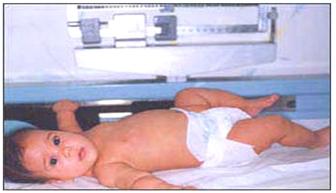
사진 3-31. 체중과 신장을 재고 체중 치와 신장 치를 성장차트에 그린다.
그 영아 자신의 성장 속도에 따라 적절하게 성장하는지 알아본다.
Copyright ⓒ 2012 John Sangwon Lee, MD., FAAP
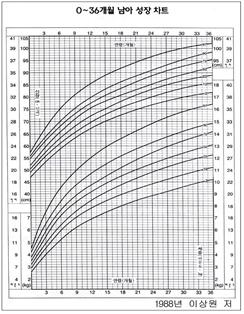
그림 3-32. 생후 0~36개월 된 한국 남 신생아들과 남 영유아들의 성장차트와 백분위수.
Copyright ⓒ 2012 John Sangwon Lee, MD., FAAP
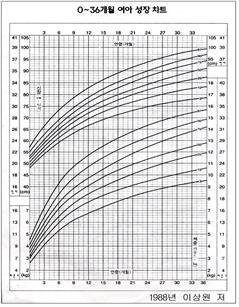
그림 3-33. 생후 0~36개월 된 한국 여 신생아들과 여 영유아들의 성장차트와 백분위수.
Copyright ⓒ 2012 John Sangwon Lee, MD., FAAP
- 잰 체중 치와 신장 치를 성장차트 체중 신장·백분위선에 그려본다.
- 체중과 신장이 성장차트 체중 신장 백분위선 상 어디에 있는지 알아본다.
- 그 영아의 체중과 신장이 자신의 성장차트 체중 신장 백분위선을 따라 예측한대로 계속 증가되면서 정상적으로 자라고 있다는 것을 알 수 있다.
- 이 시기의 대부분의 영아들의 체중은 하루 15g 정도 는다.
- 생후 4∼6개월의 영아들의 체중은 출생 시의 체중의 2배가 된다.
- 이 나이의 영아들의 뒷머리 부위 중앙에 있는 소천문이 막히는 것이 보통이다.
- 아래의 중앙 앞 젖니는 생후 5∼9개월경에 나는 것이 보통이다.
- 정상적으로 생후 4개월 경 첫 젖니가 일찍이 나기도 하고, 돌 전후 첫 젖니가 늦게 날 수 있다.
| 생후 4∼6개월 영아들의 발육 |
Development of 4~6 month old infants
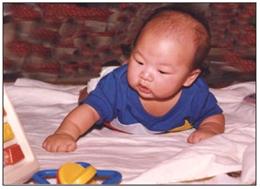
사진 3-34. 생후 4~6개월 된 영아는 장난감을 가지고 싶으면 손을 뻗쳐 가질 수 있다.
Copyright ⓒ 2012 John Sangwon Lee, MD., FAAP
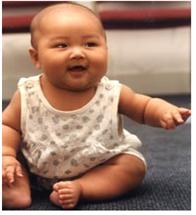
사진 3-35. 생후 4~6개월 된 대부분 영아들은 4~8개월에 혼자 앉을 수 있다.
Copyright ⓒ 2012 John Sangwon Lee, MD., FAAP
1. 생후 4∼6개월 영아들의 신체 발육
- 생후 4개월 경 바닥에 등을 대고 누워있는 영아의 두 손을 잡고 위쪽으로 끌어 앉히면 힘 있게 몸통을 움직여 앉으려고 한다.
- 몸통을 두 손으로 잡고 세우면 다리에 힘을 어느 정도 주고 설 수 있다.
- 양쪽 팔을 붙들고 누워있는 영아를 일으킬 때 목에 힘을 주어 목을 빳빳이 곧게 세울 수 있다. 목을 이쪽저쪽으로 돌릴 수 있다.
- 사방을 두리번거리면서 볼 수 있다.
- 바닥에 엎어 뉘면 머리, 얼굴, 앞가슴을 바닥 위에서 조금 위쪽으로 들어 올릴 수 있다.
- 양손으로 허리를 붙들고 세우면 발을 구르면서 좋아한다.
- 목욕통 물속에서 물장구치면서 놀기 좋아한다.
- 발육이 빠른 아기는 혼자서 앉고 앞․뒤쪽으로 뒤집기 할 수 있다.
2. 생후 4∼6개월 영아들의 손 발육
- 자신의 손을 들여다보면서 놀 수 있다.
- 한쪽 손으로 다른 쪽 손을 만질 수 있다.
- 한 손으로 다른 손을 붙들고 잡아당길 수 있다.
- 손에 닿을 수 있는 곳에 놓은 장난감을 보면 손을 뻗쳐 잡을 수 있다.
- 바닥에 등을 대고 누워있을 때 자기 발을 손으로 잡고 놀고 때로는 그 발을 빨기도 한다.
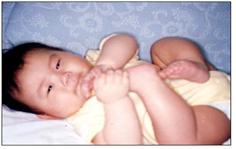
사진 3-36.이 나이 영아들은 자기 발도 빨고 자기 손도 잘 빤다.
Copyright ⓒ 2012 John Sangwon Lee, MD., FAAP
3. 생후 4∼6개월 영아들의 언어 발육
- 4~5개월 된 대부분의 영아들은 자기가 필요한 것이 있으면 울음 말로 필요한 것을 달라고 의사표시를 한다.
- 울 때 친밀한 목소리로 달래면 울음을 곧 그칠 수 있다.
- 소리를 크게 내어 웃을 수 있다.
- 엄마 아빠의 목소리나 낯익은 사람들의 목소리를 분별할 수 있다.
- 즐겁고 기쁘면 ‘우’ 나 ‘아’ 와 비슷한 옹알옹알 아기소리를 낼 수 있다.
- 소리가 나는 쪽으로 머리를 돌릴 수 있고 말하는 사람을 쳐다볼 수 있다.
- 가지고 놀던 장난감을 손에서 놓치거나 잃어버리면 좋아하지 않는다.
4. 생후 4∼6개월 영아들의 사회성 발육
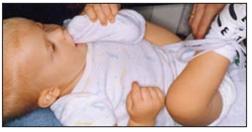
사진 3-37. 이때의 영아들은 자기 손발 등을 정상적으로 잘 빤다.
Copyright ⓒ 2012 John Sangwon Lee, MD., FAAP

사진▴3-38. 이때의 영아들은 자기 손발 등을 정상적으로 잘 빤다.
Copyright ⓒ 2012 John Sangwon Lee, MD., FAAP
- 엄마나 아빠 또는 누구보고 자기와 함께 놀고 자기를 돌보아 달라고 울어서 표현하거나 보채거나 몸짓 말과 눈길 접촉으로, 또는 감정으로 표시한다.
- 이때의 영아들의 대부분은 혼자서 놀기를 아주 싫어하고 엄마아빠와 항상 함께 있기를 바란다.
- 친밀한 집안 식구들과 낯선 사람을 보고 누구인가 대략 분별할 수 있다.
- 낯선 사람을 보면 낯을 가리고 울기도 하고 두려워할 수 있다.
- 엄마아빠를 보자마자 웃고 아기 소리를 내서 반가워하고 좋아한다.
- 생후 4∼5개월 영아들의 대부분은 배에 힘을 많이 주고 소리 내어 크게 웃을 수 있다.
- 여러 가지 장난감들 중 자기가 좋아하는 장난감을 골라 가지고 놀 수 있다.
- 수면시간과 깨어 있는 시간이 24시간 밤낮 주기에 따라 확실히 정해진다.
- 그래서 먹는 시간, 깨어 있는 시간, 잠자는 시간이 전보다 더 뚜렷해진다( “생후 1개월~6세 영유아들의 더 자세한 발육 이정표” 참조).
■ 생후 4~6 개월 영아들 육아 Cares of 4~6 month old infants
| 생후 4∼6개월 영아들의 영양 |
1. 모유수유 Breast feeding
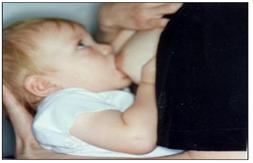
사진 3-39. 모유수유를 할 때 젖 먹는 아기와 눈을 맞추면서 수유해야 한다.
Copyright ⓒ 2012 John Sangwon Lee, MD., FAAP
2. 인공영양 Infant Formula
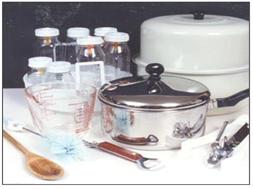
사진 3-40. 인공영양을 먹이는데 필요한 것들.
Copyright ⓒ 2012 John Sangwon Lee, MD., FAAP

사진 3-41. 인공영양을 먹이는데 필요한 여러 종류의 우유병
Copyright ⓒ 2012 John Sangwon Lee, MD., FAAP
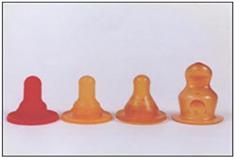
사진 3-42. 여러 종류의 우유병의 젖꼭지.
Copyright ⓒ 2012 John Sangwon Lee, MD., FAAP
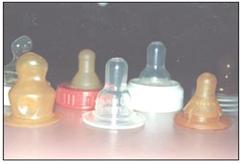
사진 3-43. 여러 종류의 우유병의 젖꼭지.
Copyright ⓒ 2012 John Sangwon Lee, MD., FAAP
4. 이유식
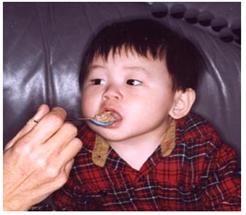
사진 3-44. 이유식은 숟가락이나 컵으로 먹인다.
Copyright ⓒ 2012 John Sangwon Lee, MD., FAAP
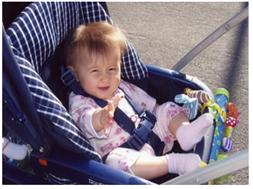
사진 3-45. 승용차를 타고 영유아를 데리고 어디를 갈 때는 국법으로 허가된 안전 의자에 태우고 차를 몬다. 이것은 법이다.
Copyright ⓒ 2012 John Sangwon Lee, MD., FAAP
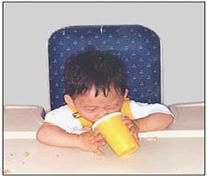
사진 3-48. 이유식은 자신이 연습용 컵으로 먹는다.
Copyright ⓒ 2012 John Sangwon Lee, MD., FAAP
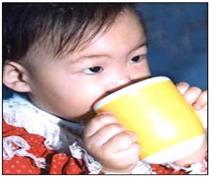
사진 3-49. 이유식은 자신이 연습용 컵으로 먹는다.
Copyright ⓒ 2012 John Sangwon Lee, MD., FAAP
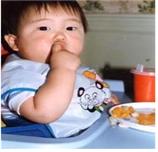
사진 3-50. 이유식을 손으로 먹게 한다.
Copyright ⓒ 2012 John Sangwon Lee, MD., FAAP
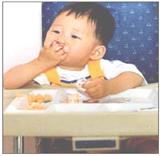
사진 3-51. 이유식을 손으로 먹게 한다.
Copyright ⓒ 2012 John Sangwon Lee, MD., FAAP
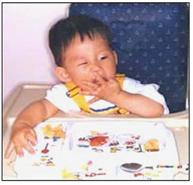
사진 3-52. 이유식을 손으로 먹게 한다.
Copyright ⓒ 2012 John Sangwon Lee, MD., FAAP
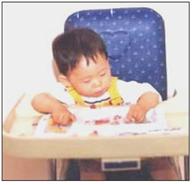
사진 3-53. 이유식을 손으로 먹게 한다.
Copyright ⓒ 2012 John Sangwon Lee, MD., FAAP
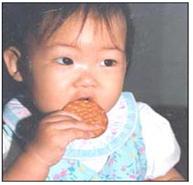
사진3-54.생후 6개월 이후 이유식 영유아용 과자를 손으로 먹을 수 있다.
Copyright ⓒ 2012 John Sangwon Lee, MD., FAAP
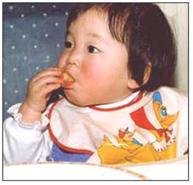
사진 3-55.생후 6개월 이후 이유식 영유아용 과자를 손으로 먹을 수 있다.
Copyright ⓒ 2012 John Sangwon Lee, MD., FAAP
Growth and development of 4-6 month-old infants
Table 3-4. Percentiles of Weight and Height for Korean Infants at 4 Months of Age
표 3-4. 생후 4개월 된 한국 영아들의 체중과 신장의 백분위수
|
Percentile
gender |
3 | 10 | 25 | 50 | 75 | 90 | 97 | |
| boy | weight(kg) | 5.70 | 6.20 | 6.80 | 7.30 | 8.00 | 8.70 | 9.40 |
| height(cm) | 59.0 | 61.0 | 63.0 | 64.6 | 66.2 | 68.2 | 70.1 | |
| girl | weight(kg) | 5.10 | 5.90 | 6.40 | 6/86 | 7/30 | 8.20 | 9.10 |
| height(cm) | 58.0 | 60.0 | 61.6 | 63.2 | 65.0 | 67.4 | 69.3 |
Table 3-5. Percentiles of weight and height of 5-month-old Korean infants 표 3-5. 5개월 한국 영아들의 체중과 신장의 백분위수
|
Percentile
gender |
3 | 10 | 25 | 50 | 75 | 90 | 97 | |
| boy | weight(kg) | 6.0 | 6.50 | 7.09 | 7.73 | 8.35 | 9.00 | 9.60 |
| height(cm) | 59.9 | 62.0 | 64.0 | 66.0 | 68.0 | 69.7 | 72.0 | |
| girl | weight(kg) | 5.45 | 6.00 | 6.60 | 7.23 | 8.00 | 8.50 | 9.39 |
| height(cm) | 59.0 | 61.4 | 63.0 | 65.0 | 67.9 | 68.6 | 72.0 |

Picture 3-31. Measure the weight and height, and draw the weight and height values on the growth chart. See if the child is growing appropriately according to his or her own growth rate. Copyright ⓒ 2012 John Sangwon Lee, MD., FAAP

Figure 3-32. Growth charts and percentiles of Korean male newborns and male infants aged 0 to 36 months of age. Copyright ⓒ 2012 John Sangwon Lee, MD., FAAP

Figure 3-33. Growth charts and percentiles of Korean newborn girls and young girls aged 0 to 36 months. Copyright ⓒ 2012 John Sangwon Lee, MD., FAAP
Draw the measured weight and height on the growth chart weight height/percentile line. Find out your child’s weight and height on the growth chart weight and height percentiles.
It can be seen that the infant’s weight and height continue to increase as predicted along with the weight and height percentile of his growth chart, indicating that he is growing normally. Most infants at this age weigh about 15 grams per day. Infants between 4 and 6 months of age weigh twice as much as their birth weight. It is common for infants of this age to have a closed posterior fontanel in the center of the occipital region.
It is normal for the lower middle front milk teeth to appear around 5 to 9 months of age. Normally, around 4 months of age, the first teething teeth may appear early, and the first teething teeth may appear later before or after birth. Development of infants 4-6 months old
Development of 4-6 months old infants

Picture 3-34. Infants aged 4 to 6 months can reach out and have toys if they wish. Copyright ⓒ 2012 John Sangwon Lee, MD., FAAP

Picture 3-35. Most infants aged 4 to 6 months are able to sit alone at 4 to 8 months of age. Copyright ⓒ 2012 John Sangwon Lee, MD., FAAP
1. Physical development of infants aged 4-6 months at around 4 months of age, hold the hands of an infant lying on their back on the floor and pull them upwards to forcefully move her torso to sit. If you hold the body with both hands and stand up, the infant can have the legs some strength and stand up.
When raising the infant from lying down holding both arms, he can straighten the neck by applying pressure to the neck. He can turn his neck from side to side. He can look around and see.
Lie face down on the floor to lift his head, face, and chest slightly above the floor. If you hold his back with both hands and stand up, he like to roll your feet. He likes to play while splashing around in the water in the bathtub. Babies who are developing quickly can sit on their own and flip back and forth.
2. Hand development of 4-6-month-old infants
He can play while looking into your own hands. One hand can touch the other. One hand can hold and pull the other hand. If he sees a toy placed within reach, he can reach out and grab it. When lying on his back on the floor, he grabs his feet and plays with them, sometimes sucking them.

Picture 3-36. Infants of this age suck their feet and their hands well. Copyright ⓒ 2012 John Sangwon Lee, MD., FAAP
3. Language development of 4-6-month-old infants
Most infants aged 4-5 months express their need by crying when they need it. When he cries, if you comfort it with a friendly voice, he can stop crying soon. He can laugh out loud. They can discern the voices of mothers and fathers and the voices of familiar people. If they are happy and happy, you can make baby sounds similar to ‘wow’ or ‘ah’. He can turn his head toward the sound and look at the person speaking. He doesn’t like when he loses a toy he used to play with.
4. Social development of 4-6-month-old infants

Picture 3-37. Infants at this time normally suck their hands and feet well. Copyright ⓒ 2012 John Sangwon Lee, MD., FAAP

Picture 3-38. Infants at this time normally suck their hands and feet well. Copyright ⓒ 2012 John Sangwon Lee, MD., FAAP
Crying to ask mom, dad, or someone to play with them and take care of them, show them by crying, scolding, body language, eye contact, or emotion.
Most infants at this age do not like to play alone and want to be with their mothers and fathers all the time. By looking at close family members and strangers, they can roughly discern who they are. Seeing a stranger can make them hide their face, cry, and be afraid.
As soon as they see mom and dad, they laugh and make baby noises, so they are happy and like it. Most infants 4-5 months old can laugh out loud with a lot of pressure on their stomachs.
You can choose from a variety of toys to play with. Sleep and awake times are clearly determined by a 24-hour day and night cycle.
So eating, waking, and sleeping times are more distinct than ever before (see “More detailed developmental milestones for infants 1 month to 6 years old”).
Care of 4-6-month-old infants
Nutrition for infants 4-6 months old
1. Breastfeeding

Picture 3-39. When breastfeeding, make sure to make eye contact with the infant who is breastfeeding. Copyright ⓒ 2012 John Sangwon Lee, MD., FAAP
2. Artificial Nutrition Infant Formula

Picture 3-4. What is needed for artificial nutrition?. Copyright ⓒ 2012 John Sangwon Lee, MD., FAAP

Picture 3-41. Different types of milk bottles needed for artificial nutrition. Copyright ⓒ 2012 John Sangwon Lee, MD., FAAP

Picture 3-42. The nipple of different types of milk bottles. Copyright ⓒ 2012 John Sangwon Lee, MD., FAAP

Picture 3-43. The nipple of different types of milk bottles. Copyright ⓒ 2012 John Sangwon Lee, MD., FAAP 4. Baby food

Picture 3-44. Feed baby food with a spoon or cup. Copyright ⓒ 2012 John Sangwon Lee, MD., FAAP

Picture 3-45. When traveling with infants and toddlers in a car, put them in a safety seat approved by national law and drive the car. This is the law. Copyright ⓒ 2012 John Sangwon Lee, MD., FAAP

Picture 3-48. Baby food is eaten from the cup for practice. Copyright ⓒ 2012 John Sangwon Lee, MD., FAAP

Picture 3-49. Baby food is eaten from the cup for practice. Copyright ⓒ 2012 John Sangwon Lee, MD., FAAP

Picture 3-50. Have them eat baby food with their hands. Copyright ⓒ 2012 John Sangwon Lee, MD., FAAP

Picture 3-51. Have them eat baby food with their hands. Copyright ⓒ 2012 John Sangwon Lee, MD., FAAP

Picture 3-52. Have them eat baby food with their hands. Copyright ⓒ 2012 John Sangwon Lee, MD., FAAP

Picture 3-53. Have them eat baby food with their hands. Copyright ⓒ 2012 John Sangwon Lee, MD., FAAP

Photo 3-54. After 6 months of age, baby food can be eaten with your hands. Copyright ⓒ 2012 John Sangwon Lee, MD., FAAP

Photo 3-55. After 6 months of age, you can eat baby food sweets with your hands. Copyright ⓒ 2012 John Sangwon Lee, MD., FAAP
출처 및 참조문헌
- Nelson Textbook of Pediatrics 22ND Ed
- The Harriet Lane Handbook 22ND Ed
- Growth and development of the children
- www.drleepediatrics.com 제1권 소아청소년 응급 의료
- www.drleepediatrics.com 제2권 소아청소년 예방
- www.drleepediatrics.com 제3권 소아청소년 성장 발육 육아
- www.drleepediatrics.com 제4권 모유,모유수유, 이유
- www.drleepediatrics.com 제5권 인공영양, 우유, 이유식, 비타민, 미네랄, 단백질, 탄수화물, 지방
- www.drleepediatrics.com 제6권 신생아 성장 발육 육아 질병
- www.drleepediatrics.com제7권 소아청소년 감염병
- www.drleepediatrics.com제8권 소아청소년 호흡기 질환
- www.drleepediatrics.com제9권 소아청소년 소화기 질환
- www.drleepediatrics.com제10권. 소아청소년 신장 비뇨 생식기 질환
- www.drleepediatrics.com제11권. 소아청소년 심장 혈관계 질환
- www.drleepediatrics.com제12권. 소아청소년 신경 정신 질환, 행동 수면 문제
- www.drleepediatrics.com제13권. 소아청소년 혈액, 림프, 종양 질환
- www.drleepediatrics.com제14권. 소아청소년 내분비, 유전, 염색체, 대사, 희귀병
- www.drleepediatrics.com제15권. 소아청소년 알레르기, 자가 면역질환
- www.drleepediatrics.com제16권. 소아청소년 정형외과 질환
- www.drleepediatrics.com제17권. 소아청소년 피부 질환
- www.drleepediatrics.com제18권. 소아청소년 이비인후(귀 코 인두 후두) 질환
- www.drleepediatrics.com제19권. 소아청소년 안과 (눈)질환
- www.drleepediatrics.com 제20권 소아청소년 이 (치아)질환
- www.drleepediatrics.com 제21권 소아청소년 가정 학교 간호
- www.drleepediatrics.com 제22권 아들 딸 이렇게 사랑해 키우세요
- www.drleepediatrics.com 제23권 사춘기 아이들의 성장 발육 질병
- www.drleepediatrics.com 제24권 소아청소년 성교육
- www.drleepediatrics.com 제25권 임신, 분만, 출산, 신생아 돌보기
- Red book 29th-31st edition 2021
- Nelson Text Book of Pediatrics 19th- 21st Edition
- The Johns Hopkins Hospital, The Harriet Lane Handbook, 22nd edition
- 응급환자관리 정담미디어
-
소아가정간호백과–부모도 반의사가 되어야 한다, 이상원
-
Neonatal Resuscitation American heart Association
-
Neonatology Jeffrey J.Pomerance, C. Joan Richardson
-
Pediatric Resuscitation Pediatric Clinics of North America, Stephen M. Schexnayder, M.D.
-
Pediatric Critical Care, Pediatric Clinics of North America, James P. Orlowski, M.D.
-
Preparation for Birth. Beverly Savage and Dianna Smith
-
Infectious disease of children, Saul Krugman, Samuel L Katz, Ann A. Gershon, Catherine Wilfert
- 소아과학 대한교과서
- Growth and Development of Children, Eighth Edition, George H. Lowrey, Yearbook Medical Publishers
- Growth and Development of Children, Fifth Edition, E. H. Watson and G. H. Lowrey, Yearbook Medical Publishers
- Other
|
Copyright ⓒ 2015 John Sangwon Lee, MD., FAAP 미국 소아과 전문의, 한국 소아청소년과 전문의 이상원 저 “부모도 반의사가 되어야 한다”-내용은 여러분들의 의사로부터 얻은 정보와 진료를 대신할 수 없습니다. “The information contained in this publication should not be used as a substitute for the medical care and advice of your doctor. There may be variations in treatment that your doctor may recommend based on individual facts and circumstances. “Parental education is the best medicine.” |